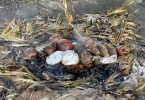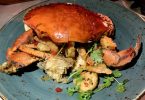After leaving Bordeaux, we take the RN137 up to Pons then along the picturesque D732 that lead us to Cognac. This small, somnolent town lying on the gentle banks of the Charentes river offers the visitor tours and tastings at the major Cognac houses such as Martell, Hennessy, Otard and Hine. It enjoyed its prime time in the fifteenth century when the Valois was in power. From its calm location, it is difficult to imagine that it endured the Hundred Year War. However, the Charentes river was an important channel of commerce during the fifteenth century exporting salt, wine and Cognac.
Known for the production of high quality butter, the region of Charentes is also famous for the vineyards that produce the wine distilled for Cognac. Surprisingly and without getting lost, we find ourselves at Société Martell & Co, the oldest Grande Maison, founded in 1715 by Jean Martell, an expatriate of the Channel Islands.
Visit to Martell
We park our Renault 19 and enter the foyer where we are greeted by hosts and hostesses dressed in a business-like manner. Une visite? En français ou en anglais? Please fill in a form. The multilingual hosts offer us a seat in a large, comfortable lounge and we are given informative brochures about the house of Martell.
The guided visit begins by visiting the ageing chais, the blending room, the bottling plant, all intermingled with on-site audio-visual documentaries on the different stages of Cognac production. The hour-long tour terminates with a tasting in a large decorated room displaying and selling various bottles of Martell and memorabilia. We are given a miniature bottle as a souvenir.
 We learn that the department of Charentes has a unique chalky soil which provides the vineyards with the correct conditions to produce eaux-de-vie of different taste and quality. To qualify for the appellation Cognac, the vineyards must be located in an area defined by a decree on May 1 1909 and the wine must be produced and distilled within these borders. The divisions, occurring in a concentric form radiating from the town of Cognac have a hierarchy of quality in the following order: Grande Champagne, Petite Champagne, Borderies, Fins Bois, Bons Bois and Bois Ordinaires.
We learn that the department of Charentes has a unique chalky soil which provides the vineyards with the correct conditions to produce eaux-de-vie of different taste and quality. To qualify for the appellation Cognac, the vineyards must be located in an area defined by a decree on May 1 1909 and the wine must be produced and distilled within these borders. The divisions, occurring in a concentric form radiating from the town of Cognac have a hierarchy of quality in the following order: Grande Champagne, Petite Champagne, Borderies, Fins Bois, Bons Bois and Bois Ordinaires.
 The Grande et Petite Champagne regions produce eaux-de-vie that are strong and subtle requiring long ageing periods. The Borderies on the north banks of the Charentes provides a soft bouquet with a slight flavour of violets. The Fins Bois produce lighter eaux-de-vie which age more rapidly; they add body and structure and play an important role in blending. The Bons Bois and Bois Ordinaires are the lesser of the regions.
The Grande et Petite Champagne regions produce eaux-de-vie that are strong and subtle requiring long ageing periods. The Borderies on the north banks of the Charentes provides a soft bouquet with a slight flavour of violets. The Fins Bois produce lighter eaux-de-vie which age more rapidly; they add body and structure and play an important role in blending. The Bons Bois and Bois Ordinaires are the lesser of the regions.
The grape varieties are St-Emilion, Folle Blanche, Ugni Blanc and Colombard. Harvests occur in October and the process of vinification is done according to traditional customs and methods.
Grape juice is left to ferment, wine is obtained and distilled. The unfiltered fermented wine is added to the alambic where it is brought to boiling point by a fire underneath. Alcohol vaporises and rises to the head, known as the chapiteau. From there it passes through a swan’s neck, col de cygne then into a cool, coiled worm, the serpentin, where it condenses back into liquid form known as eau-de-vie, about 70 degrees alcohol. The liquid obtained from the first distillation, the brouillis is returned to the still for a second distillation called la bonne chauffe. The initial condensed vapours are imperfect and high in impurities, the tails are also eliminated, leaving the middle vapours which are the best, giving Cognac its characteristic aroma.
The eaux-de-vie are laid to age for many years in casks, placed in rows containing the harvest of a particular year and property. The casks are made from oak trees in the forests of nearby Limousin and Troncais, providing a strong wood rich in tannin absorbed by the Cognac to give it its distinctive amber colour and aroma. The barrels are hand made by tonneliers or coopers employing traditional methods where no nails or glue are used.
Sadly for the Cognac houses but not for visitors, about 3% of the Cognac evaporates through the porous wood producing a wonderful cavernous odour in the warehouses. Referred to as the “angels’ share”, or la part des anges. It is due to a fungus known as Torula Coniacensis that feeds on the fumes and has a black appearance on roofs, walls, stonework and beneath tiles wherever Cognac is stored, making it difficult for anyone to hide their stock. A microscopic crab also feeds on the barrels that are labelled in chalk in calligraphic style writing, with the name of the property from which the eau-de-vie came from.
What follows is the art of blending and mixing of different eaux-de-vie from various ages and growths to obtain a distinctive Cognac taste. The Cellar-Master, portrayed as a man of character with elaborate nostrils, buries his nose in a tulip shaped glass, swirls the liquid in his glass, takes little sips and rolls it around in his palate. The end result is a fine Cognac of consistent taste, bottled and graded according to age.
VS, Very Special is a young, good quality Cognac aged for a minimum of 2 1/2 years. VSOP, VO and Reserve Cognacs are aged for a minimum of 4 1/2 years while Napoleon is aged for a little longer. XO, Vieille Reserve and Grande Reserve are about 15-20 years old.
Visit to Hennessy

With a new-founded knowledge and a breakfast of Cognac tasting, we are ready for more. We drive to Société Jas Hennessy & Co. on rue de la Richonne pour faire une petite visite. Attractive French hostesses seat us in the lounge.
“Dans cinq minutes,” In five minutes, the announcement is made.
The lounge fills very quickly with visitors from England, the US and Germany. We are taken to an auditorium for an audio-visual with a commentary by Peter Ustinov which explains that Richard, son of Charles Hennessy, Lord of Ballymacmoy in Ireland, ended up in France in 1760 on Ile de Re where he left the military service for life in Cognac. After sending home a few casks, orders flooded in and he decided to enter the Cognac trade and established a firm in 1765. His son James named it Jas Hennessy and it became world famous.
We are escorted to the banks of the Charentes awaiting a driver to take us on a Hennessy boat. We jump to the head of the queue to get a front seat for what we thought to be, a short river cruise only to be consoled with a quick crossing to the other side of the river! We are shown the large, ageing chais where we inhale the aromatic vapours and view another video presentation on a barrel shaped screen.
We returned via the boat to the other bank of the Charentes, where a considerate driver stops her car with a smile to allow our rather large group to cross the road. We return to the Hennessy premises for a long and uninteresting visit to the cooperage museum which terminates with no tasting. We are given a miniature bottle and a booklet on the house of Hennessy.
Ready for more sampling but feeling rather light-headed and hungry, we stop by our car to grab the little baguette I had with me from breakfast. The heat in the car had roasted the bread as if it just came out of an oven.
A young man stops us and asks in broken French if we had passed a blanchisserie or a laundry. Cognac attracts young Britons in summer who come to work as tour hosts and enjoy the offerings.
Visit to Otard Dupuy
Our next stop is Otard Dupuy, home of Francois 1e, born in 1494, a former chateau rich in history. Set in the medieval Chateau de Cognac or Chateau des Valois, this was by far the most informative, visually appealing and entertaining of all the tours. We sit in the base of the tower where a life size Francois 1e on film welcomes and us introduces us to his chateau. This is followed by a little walk through the ancient premises, where light and music precede our steps and a commentary is presented. Amidst the dark, fungi covered walls, we inhale the distinctive aroma while our minds were broadened by new knowledge.
The medieval Chateau had its origins in the ninth century and later became a fortress when Cognac was under the rule of the Dukes of Aquitaine. During the Hundred year War, it had many occupants including the Black Prince and Bertrand de Guesclin who retrieved it from the English in 1375. It was under the Valois that it flourished. Later in 1795 Baron Otard of Scotland, followed King James into exile, bought the chateau and began a business in Cognac.
From the dark caves we ascend a few stairs to a renovated section of the court. It was there, among historical occurrence that we congregated near four television sets placed remotely in four corners of the court and listened to the origins of Cognac intermingled with historically relevant commentaries.
We are then taken to a cellar where barrels are stored to age and explained the process of double distillation in front of a still, surrounded by various amber shaded little bottles of eau-de-vie. The tour concludes in a small tasting room with bottles of Otard on sale. We emerge at the back of the chateau in front of Fontaine Francois 1e feeling like we stepped back into history
Our journey to Cognac has enhanced our appreciation for its amber liquid and educated our minds. We farewell Cognac, a quiet little town we hope to return to for a longer visit.
… continues tomorrow
‘Le Tour de France Gourmantic’ series is the story of a young couple from Australia who took to the French roads on a whirlwind Tour of France back when the internet wasn’t at everyone’s fingertips, phones were still attached to sockets, GPS was an unfamiliar acronym, digital cameras were a pipe dream and the Euro hadn’t replaced French Francs. With just one fold-out map of France and boundless enthusiasm, they took their Renault 19 and went on a cultural and culinary discovery.













[…] This post was mentioned on Twitter by Marie HALLIER, Ms Gourmantic. Ms Gourmantic said: Going to Cognac? We visited 3 Cognac Houses: Martell, Hennessy & Otard Dupuy http://bit.ly/cMpCux Le Tour de France continues on G #tdf […]
[…] Cognac and the angels’ share behind, we take the RN141 to Saintes then join the N137 directly to La Rochelle. Our day has been […]
I could live amongst the barrels in the Cognac Houses and suck up those vapours all day long. Seriously!
Super post!
We did that on a subsequent trip. We spent the day in Cognac soaking it up. We didn’t want to leave!
[…] many Cognac houses, HINE has its roots in England. Founder Thomas Hine was born in Dorset, England and moved to France […]
[…] gin with vigne, a small-batch gin crafted with grape spirit and produced in the French region of Cognac. The gin is infused with the vine flower as well as nine other botanicals which give it its unique […]